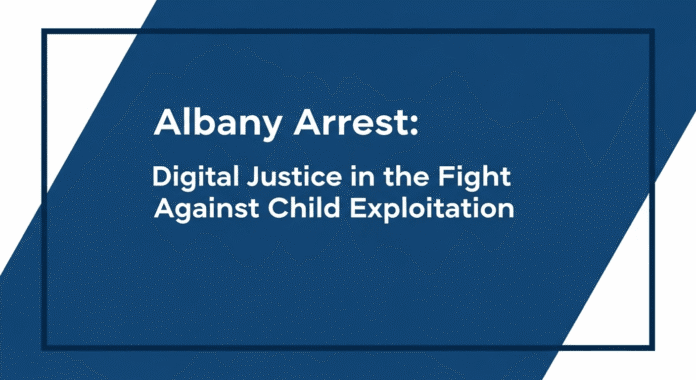How a July 2025 Arrest in Albany Sheds Light on Modern Investigations and Community Safety
On July 9, 2025, law enforcement in New York made a significant arrest that underscores the evolving battle against online child abuse. The arrest of 28-year-old Matthew T. Bess in Albany, NY, for possessing a sexual performance by a child draws attention to the role of digital forensics and inter-agency cooperation. This article explains the incident, discusses the legal and investigative framework, and reflects on national trends and concerns regarding justice and civil liberties in child exploitation cases.
The Arrest and Its Legal Significance
What Happened in Albany?
Law enforcement officials acted decisively on July 9, 2025, when New York State Police, supported by the Troop G Computer Crimes Unit and the Internet Crimes Against Children (ICAC) Taskforce, arrested Matthew T. Bess at his Albany residence. A search warrant executed at his home uncovered images that law enforcement believes constitute child sexual abuse material obtained through online channels. Bess was processed at the State Police facility in Latham, then arraigned at Albany City Court, where he was released on his own recognizance pending further proceedings.
The Charge Explained
Under New York Penal Law Section 263.16, Bess faces a charge for possessing a sexual performance by a child—a classification defined as a class “E” felony. This crime involves knowingly possessing or accessing, with the intent to view, any performance depicting sexual conduct by a child under the age of 16. Although a class “E” felony is considered the least severe of the New York felonies, it carries serious consequences including potential prison time of up to four years, probation, fines, and mandatory sex offender registration. The legal framework is designed to safeguard children while ensuring that technological evidence is carefully scrutinized in a court of law.
“Digital forensics is critical in modern investigations because it ensures that digital evidence is recovered and analyzed properly. This is essential for its integrity and admissibility in court,” explained a law enforcement official involved in these types of investigations.
Digital Forensics and Inter-Agency Collaboration
The Modern Investigative Process
The investigation into Bess’s activities relied heavily on digital forensic methods. Modern investigations in child sexual exploitation cases involve several critical steps:
• Law enforcement monitors internet activity for patterns that suggest the downloading or distribution of illegal images.
• Search warrants are obtained to legally access personal devices where suspicious data might be stored.
• Digital forensic experts analyze seized computers and mobile devices, ensuring that any evidence is securely handled and traced back to its origin.
These methods not only expedite the investigative process but also provide reliable evidence in the courtroom.
Bringing Teams Together
The success of Bess’s arrest resulted from the concerted efforts of multiple agencies. The New York State Police Troop G Computer Crimes Unit provided local expertise in forensic analysis, while the ICAC Taskforce contributed specialized knowledge and national resources. This collaboration across jurisdictions and disciplines showcases an effective model in combating online child exploitation. One expert noted, “Standardized processes and cooperative investigations between local and national agencies significantly enhance the reliability of digital evidence.”
By combining their efforts, these agencies demonstrate how inter-agency collaboration can overcome jurisdictional challenges, making it possible to track and apprehend offenders no matter where the digital trails lead.
National Trends in Combating Child Exploitation
A Growing Problem
The arrest of Bess in Albany is part of a larger national effort aimed at protecting children online. In May 2025, a coordinated operation—Operation Restore Justice—resulted in the arrest of 205 offenders nationwide and the rescue of 115 children. In New York alone, similar cases have led to the apprehension of several individuals involved in possessing and distributing child sexual abuse material.
This upward trend is fueled in part by technological advancements that enable more efficient tracking of criminal behavior across digital networks. Innovations in digital forensics, fueled by enhanced software tools and inter-agency cooperation, have become critical in identifying patterns and intercepting child exploitation before further harm is done.
The Impact of Technology
Digital forensics now stands at the forefront of modern law enforcement techniques. Agencies worldwide use advanced software to decrypt data and reveal the hidden behaviors of online predators. The ICAC Taskforce has consistently demonstrated that the integration of technology with traditional investigative methods results in more successful operations. Routine cyber operations and specially coordinated stings have proven that technology is a powerful tool in both investigation and prevention.
Moreover, community reporting and data from organizations like the National Center for Missing and Exploited Children (NCMEC) allow law enforcement to receive valuable leads. By combining public tips with high-tech analysis, agencies create a comprehensive defense against those who seek to exploit minors.
Balancing Justice, Privacy, and Civil Liberties
Concerns Over Due Process
While modern investigative methods are essential in combating heinous crimes, they raise important due process issues. Digital evidence, by its nature, is prone to challenges regarding its collection and preservation. Without standardized protocols, evidence can be vulnerable to claims of tampering or misinterpretation. The integrity and reliability of digital data remain frequented topics in legal debates, and ongoing discussions emphasize the need to protect the rights of the accused even in serious crimes such as child exploitation.
Privacy in a Digital Age
Accessing and analyzing personal devices is now a commonplace part of investigations into online abuse. Privacy advocates caution that such practices may overreach and inadvertently infringe on the constitutional rights of the individual targeted by the investigation. The Fourth Amendment protects citizens from unreasonable searches and seizures, and disputes arise when modern technology pushes the boundaries of these protections. Responsible investigative measures must strike a delicate balance between safeguarding children and protecting individual privacy.
Upholding the Presumption of Innocence
Accusations of child exploitation are heavily stigmatized by society, often leading to premature public judgment and media bias. Legal experts warn that the technical nature of digital evidence may obscure the presumption of innocence until all facts are brought before a court. Advanced digital investigations may shift the burden of proof onto the defendant, demanding that the accused clarify the provenance of every piece of online data associated with their case. Maintaining fairness in the legal process is essential to avoid undermining the foundational principle that every person is innocent until proven guilty.
Community Impact and the Path Forward
A Call to Action
The implications of cases like that of Matthew T. Bess extend far beyond the courtroom. They emphasize the necessity of vigilance in both digital and real-life environments. Families, educators, and community leaders are encouraged to stay informed about the risks children face online. Public awareness can drive faster law enforcement responses and ensure that fewer children fall victim to exploitation.
Citizens can make a difference by:
• Educating themselves and their families on online safety practices
• Reporting suspicious online activity to federal or local authorities
• Supporting organizations that assist victims and promote digital safety measures
This case serves as a reminder that our collective action is necessary to protect the just and safe use of technology.
Looking to the Future
As technology continues to evolve, so too will the methods used by both criminals and law enforcement. Continuous improvement in digital forensic techniques and inter-agency cooperation is crucial to stay ahead of those exploiting digital vulnerabilities. Laws and policies must also adapt to balance effective investigations with the protection of civil liberties. It is through constant review, the integration of advanced technology, and active community participation that we can forge a safer digital landscape.
Safeguarding Our Future Through Digital Justice
The arrest of Matthew T. Bess marks a critical chapter in the fight against child exploitation. It underscores the importance of digital forensics, collaborative investigations, and an unwavering commitment to both child safety and justice. By staying informed, advocating for balanced policies, and engaging in community efforts, we can contribute to a safer online world where justice prevails without sacrificing the freedoms that define our society.
Take action now by sharing this story and educating those around you. Stay alert, report suspicious activity, and support efforts that set a precedent for fairness and protection.




